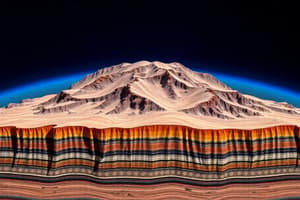Podcast
Questions and Answers
Что является жестким внешним слоем Земли, включающим кору и верхнюю часть мантии?
Что является жестким внешним слоем Земли, включающим кору и верхнюю часть мантии?
- Ядро
- Мантия
- Плиты
- Литосфера (correct)
Что генерирует магнитное поле Земли?
Что генерирует магнитное поле Земли?
- Мантия
- Кора
- Литосфера
- Ядро (correct)
Что является внешним слоем Земли, разбитым на несколько плит, которые двигаются независимо друг от друга?
Что является внешним слоем Земли, разбитым на несколько плит, которые двигаются независимо друг от друга?
- Литосфера
- Ядро
- Мантия
- Кора (correct)
Что приводит к движению этих плит?
Что приводит к движению этих плит?
Какие элементы составляют внутренний ядро Земли?
Какие элементы составляют внутренний ядро Земли?
Что генерирует магнитное поле Земли?
Что генерирует магнитное поле Земли?
Из каких пород в основном состоит мантия Земли?
Из каких пород в основном состоит мантия Земли?
В какой части земной коры находится литосфера?
В какой части земной коры находится литосфера?
Flashcards are hidden until you start studying
Study Notes
The Structure of Earth: Understanding the Core, Mantle, Crust, and Lithosphere
The Earth, being the only known planet to support life, is a complex and fascinating entity. Its structure is composed of four main layers, each with distinct properties and functions. These layers are the core, mantle, crust, and lithosphere. In this article, we will delve into the structure of Earth, exploring each of these layers in detail.
Core
The Earth's core is the innermost layer, located 2,200 kilometers beneath the surface. It is divided into two parts: the inner core and the outer core. The inner core is composed mostly of solid iron and nickel, with a small amount of lighter elements. The outer core is liquid and composed of iron, nickel, and lighter elements. The core is primarily responsible for generating the Earth's magnetic field through the process of convection.
Mantle
The mantle is the layer between the core and the crust. It is the largest layer in the Earth's interior and is primarily composed of silicate rocks. The mantle can be divided into two parts: the upper mantle and the lower mantle. The upper mantle, which includes the lithosphere, is solid, while the lower mantle is solid but under high pressure. The mantle plays a crucial role in the tectonic activity of the Earth, as it is responsible for the movement of the tectonic plates.
Crust
The Earth's crust is the outermost layer, ranging in thickness from 18 to 70 kilometers. It is composed of several types of rocks, including basalt, andesite, and granite. The crust is broken into several large plates, which float on the underlying mantle. These plates can move independently of one another, causing earthquakes and volcanic eruptions.
Lithosphere
The lithosphere is the rigid outer layer of the Earth, which includes the crust and the uppermost part of the mantle. It is divided into several large plates, which move independently of one another in a process known as plate tectonics. The movement of these plates is driven by the convection of the underlying mantle.
In conclusion, the Earth's structure is a fascinating combination of layers with unique properties and functions. The core generates the Earth's magnetic field, while the mantle drives tectonic activity. The crust is the outermost layer, broken into plates that move independently, and the lithosphere is the rigid outer layer that includes the crust and uppermost mantle. Understanding these layers and their interactions provides valuable insights into the dynamics of our planet and the processes that shape it.
Studying That Suits You
Use AI to generate personalized quizzes and flashcards to suit your learning preferences.




